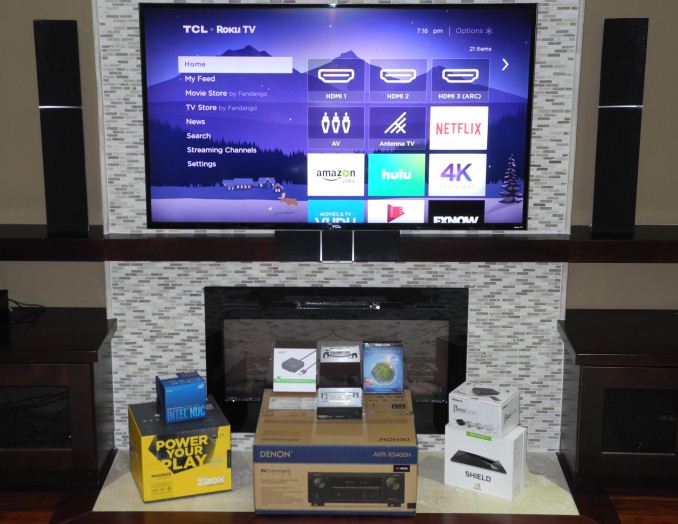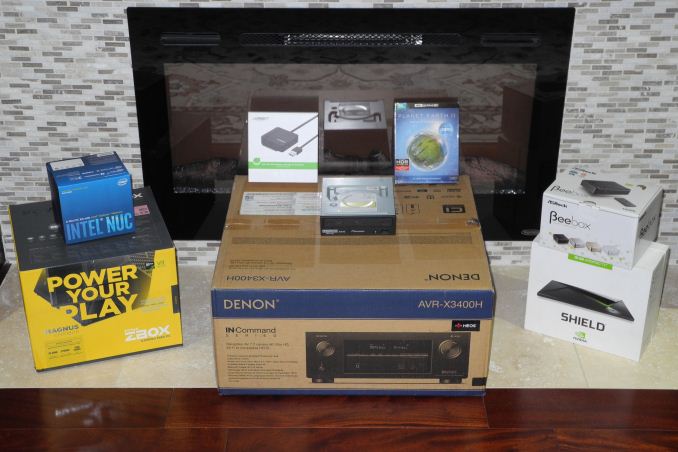A Budget Home Theater & PC Setup: 4K, HDR, UHD Blu-ray, and More
by Ganesh T S on December 26, 2017 8:30 AM EST
The days of bulky HTPCs with built-in optical drives, massive internal storage arrays, and integrated TV tuners are long gone. The advent of over the top (OTT) online streaming services has moved a lot of functionality to the cloud. As NAS units become more powerful, it has made sense to move local media files to a central repository. All these have enabled the TV-connected PC to become more compact. Unless the consumer has specific requirements (like, say, high quality gaming), even ultra-compact form factor (UCFF) machines such as the Intel NUCs can fit the bill.
Home Theater Components: Keeping up with the Times
The primary functionality of HTPCs has evolved to become one of a powerful and versatile media player. However, recent advances such as 4K and high dynamic range (HDR) videos, as well as stricter DRM requirements such as HDCP 2.2 for premium content have made the perfect HTPC platform difficult to achieve. Before delving deeper into these new advances, it is helpful to have some insight into how the landscape has changed over the last decade or so. The advancements in that timeframe have meant that next attractive home theater feature was always around the corner. In the initial days of 720p televisions and other home theater equipment, it was Full HD (1080p). As 1080p became widespread, it was HD audio bitstreaming. After that, 3D support was sought after. A brief lull ensued before the market started slowly getting ready for 4K.
Over the last year or so, we have seen the appearance of displays and audio/video receivers (AVRs) supporting HDMI 2.0 / HDCP 2.2 along with HDR / Dolby Vision. Despite the announcement of HDMI 2.1, I believe that we have reached a point where it is possible to purchase a relatively inexpensive home theater and HTPC configuration without worrying about it getting obsolete within the the next 3 to 5 years.
On the media side, OTT streaming services have become popular to the extent that Netflix and YouTube moved to offer 4K videos to consumers ahead of Blu-rays. Fortunately, many modern PCs are capable of 4K Netflix playback, though HDR is available only on a subset of those configurations. UHD Blu-ray playback support is available through CyberLink PowerDVD 17. However, the hardware requirements are a lot more specific compared to premium OTT services. UHD Blu-ray playback with HDR requires that the home theater components fulfill additional requirements.
Building a Home Theater on a Budget
I started work on this home theater piece back in June 2017. The aim was to present a setup (TV, AVR, and HTPC) with all the bells and whistles, yet light on the wallet. While the TV (TCL 55P607) and the AVR (Denon AVR X3400H) were easy to narrow down based on the feature requirements and budget, the PC side proved to be more challenging. Our core requirements (compact form factor, 4K Netflix support, and HDR capability) narrowed down the choices to a NVIDIA Pascal GPU-equipped PC or a Kaby Lake PC with HDCP 2.2 capabilities. UHD Blu-ray support further narrowed this down to certain Kaby Lake PCs with a HDMI 2.0 / HDCP 2.2 display output.
In the course of our evaluation, we found that consumer electronic (CE) equipment almost always received features ahead of HTPC platforms. Keeping this in mind, we ended up evaluating a number of options for the fulfillment of HTPC duties
- Roku Smart TV platform in the TCL 55P607
- NVIDIA SHIELD Android TV (SATV)
- Zotac ZBOX MAGNUS EN1080K
- ASRock Beebox-S 7200U
- Intel NUC7i7BNHX
Prior to looking at the performance of these options, it will be of interest to readers to delve deeper into our choice for the other home theater components. Earlier this year, I happened to embark on a house remodel, and I took that opportunity to revamp the HTPC test components used in our system reviews. Our choice of components is geared towards a typical family room (15' x 15') home theater.











191 Comments
View All Comments
Lord of the Bored - Wednesday, December 27, 2017 - link
He didn't use a DVD player. He used a BluRay player. Completely different.And until streaming gets better bitrates it is an incomplete replacement from a purely technical standpoint. I mean, when regular BR supplies 50 megabits per second, UHD BR is a hundred mbps, and UHD Netflix is 25 mbps, there is OBVIOUSLY a quality sacrifice that has to be made(though the UHD situation is better than HD, where Netflix is a ridiculously compact FIVE mbps. I'll take a quarter the data over a tenth any day).
I mean, if you don't care about image and sound quality, you may as well watch VHS tapes off that old CRT you found in gramma's garage. I always thought home theater builds were about getting the best experience, not a really expensive mediocre experience.
CharonPDX - Wednesday, December 27, 2017 - link
"without worrying about it getting obsolete within the the next 3 to 5 years."JFC... A home theater system should last far longer than 3-5 years...
Bullwinkle-J-Moose - Thursday, December 28, 2017 - link
"JFC... A home theater system should last far longer than 3-5 years..."---------------------------------------------------------------------------------------------
Not with DRM!
A mans gotta know his limitations (Clint Eastwood)
pixelstuff - Wednesday, December 27, 2017 - link
I wish the manufacturers would create a decent set of components (AVR, Blu-ray, etc) that are not more than 8" deep so you can sit them below a wall mounted TV and they don't protrude way out into the room compared to the TV.Wiring would have to be on the sides with a standardized way to hide them, but I don't think extra width would be a big issue when placed under a large TV.
Dionysos1234 - Wednesday, December 27, 2017 - link
Recommending a Denon 999$ reciever is not only NON budget - It is also an extremely poor choice for reciever in that price range from an audio perspective. Guess HTPC is not an area where Anandtech have qualified people e.g. the amount of time devoted to showing poorly made graps on power consumption seems bizarre.Aikouka - Wednesday, December 27, 2017 - link
As for all the remarks about the receiver, my biggest piece of advice is to always buy last year's model UNLESS you absolutely need a feature only on the newest model. For example, I bought an X4300 for less than the article's X3400, and there really aren't any differences that would make me consider swapping.Aikouka - Wednesday, December 27, 2017 - link
As a quick note for the uninitiated, Denon's model numbers work where the thousands place is the model number and the hundreds place is the year. So, the 4300 that I mention above is the 4th-tier model (higher is better) from the third year. The 3400 is the third-tier model from the fourth year. So, mine is a higher model, but it's a year older. To see whether it's worth an upgrade, the AVS Forum's Denon Owner's Threads usually have comparisons to previous years (e.g. X#400 vs. X#300) that can help you decide whether the latest is worth it.r3loaded - Wednesday, December 27, 2017 - link
All I'm getting from this article is that HDR is a mess of confusing and incompatible standards and support, compounded by Hollywood's almost autistic fixation with ramming DRM down the throats of anyone wanting to watch 4K HDR content, and the very specific hardware requirements that it imposes on consumers.Also, why is it that there are tons of HDR TVs on the market but barely any HDR monitors? And conversely, why does no one make a 4K HDR TV smaller than 40 inches (say, 32 inches)? Not all of us are blessed with big houses that can fit the 55 inch TV mentioned in the review.
benedict - Wednesday, December 27, 2017 - link
Yep, sounds like too much trouble for what you're getting and you always risk some weird standard won't work on your expensive setup. Until they make this as simple as torrenting a movie the home theater market will remain a very tiny niche.CityBlue - Wednesday, December 27, 2017 - link
The BDA is expected to announce that the free to licence HDR10+ open standard is being added to the UHD BluRay standard in January at CES, and not the proprietary Dolby Vision. After that announcement I imagine DV will become a niche format. HDR10+ is simply what HDR10 should always have been.HDR10+ (compared with DV) also has a dramatically easier workflow as far as creative's are concerned, so combine that with the reduced licencing cost for manufacturers and there's very little reason to choose DV - the only winner there is Dolby.
It's not yet announced, but recommending DV over HDR10+ may not be such good advice.